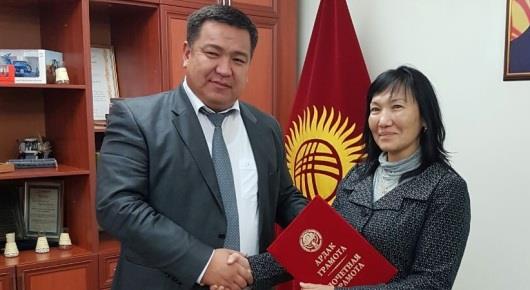Work of FAO economist recognized by Government of Kyrgyzstan

For her contribution to livestock sector development in Kyrgyzstan, an FAO economist received public recognition recently in Bishkek.
Anara Jumabayeva, senior economist with FAO’s Investment Centre, is team leader of projects funded by the International Fund for Agricultural Development (IFAD) in Kyrgyzstan, Tajikistan and Uzbekistan. Nurbek Murashev, Kyrgyzstan’s Minister of Agriculture, Food Industry and Melioration, presented her with the award during a ceremony held in December.
Historically, livestock has played an important role in income generation and food supply for rural families in Kyrgyzstan. To this day, Kyrgyz people define the wealth of a family by the number of animals it keeps.
Kyrgyzstan was one of the largest producers of mutton and wool in the Soviet Union, with over 11 million head of sheep. Seed, forage and crop production, veterinary medicine, research, educational institutes and laboratories all were oriented to supporting the livestock sector.
After the collapse of Soviet Union, followed by a financial crisis and drastic decline in public investment in the sector, Kyrgyzstan lost the largest part of its livestock. Some 80 percent of the population – especially in rural areas – fell into poverty.
“Kyrgyzstan has a high potential to broaden and strengthen its livestock sector thanks to a wealth of alpine pastures and a unique biodiversity of plants and animals,” said Jumabayeva. “Great natural resources including more than 9 million hectares of land provide broad opportunities for animal breeding and poverty alleviation. We were honored to bring IFAD’s contribution to livestock sector development in Kyrgyzstan.”
Beginning in 2008, two livestock and market development projects worth a combined total of over US$ 53 million have been financed by IFAD and coordinated by Jumbayeva on behalf of FAO. The goals are to increase livestock productivity, improve animal health, and diversify income-generating activities for rural households.
Between 2008 and 2013, production of cattle milk and meat rose by 12 and 6 percent, respectively. Livestock numbers increased, too. From 2009 to 2014, total head of cattle rose by 14 percent, horses by 16 percent, and sheep by 27 percent. Productivity of the sector as a whole also rose.
Rapid progress in the sector and new opportunities arising from Kyrgyzstan’s entry into the Eurasian Economic Union prompted the national government to name livestock value-chain development one of the country’s most urgent priorities.
In December, IFAD agreed to finance US$ 25 million of a new market access project valued at US$ 55 million. The programme is expected to increase the income of farm households and rural entrepreneurs by building more efficient value chains and using innovative new technologies.
Other expected benefits include:
- reduction of losses during production and processing of dairy and meat
- a greater share of total farm produce going to market
- improved quality and safety of agricultural and food products
- increased export of livestock commodities
- lower incidence of zoonotic diseases with improved animal sanitary systems
- greater access to credit, including longer-term loans
- higher rates of employment – both on-farm and off
- increased tax revenues thanks to increased volume of taxable production.
“I am proud of the work we have done and what we have accomplished,” said Jumbayeva. “Most importantly, we have helped to create strong national capacity to carry the work forward and continue developing this important sector for Kyrgyzstan.”
6 January 2017, Bishkek, Kyrgyzstan
